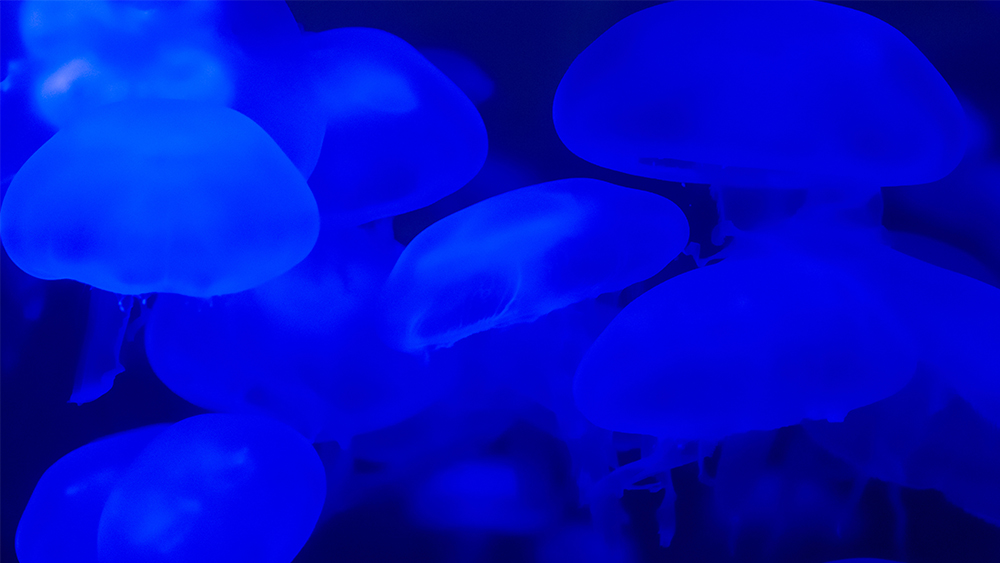Paleontologists continue to identify creatures that inhabited the waters of the “ancient” Cambrian ocean to be just like what we find in the shallow seas of the 21st century.
If you were to swim in the ‘Cambrian seas’ (from the time before the Flood), what would you find? An amazing variety of complex life forms such as echinoderms (e.g. sea stars), lampshells, snails, clams, and perhaps the most complex of all invertebrates: the shelled squids we call the nautiloids.1,2 We would also find the complex arthropod called the trilobite3 (extinct today) with its geometrically amazing compound eyes.
Now we can add to this list a recent discovery of the oldest known swimming jellyfish: “The Royal Ontario Museum (ROM) announces the oldest swimming jellyfish in the fossil record with the newly named Burgessomedusa phasmiformis.”4 This creature was found in the Burgess Shale.5
The Burgess Shale of British Columbia is arguably the most important fossil deposit in the world, providing an astounding record of the Cambrian "Explosion," the rapid flowering of complex life from single-celled ancestors. While most of the fossil record is comprised of shells, teeth and bones, the Burgess Shale preserves the softer bits—the eyes, guts, gills and other delicate structures—of animals belonging to Earth's earliest complex ecosystems a half a billion years ago.6
The discovery was formally introduced in the journal Proceedings of the Royal Society B: “Here we describe Burgessomedusa phasmiformis gen. et sp. nov., the oldest unequivocal macroscopic free-swimming medusa in the fossil record. Our study is based on 182 exceptionally preserved body fossils from the middle Cambrian Burgess Shale. (Raymond Quarry, British Columbia, Canada).”7
There’s nothing simple about the jellyfish. Even though they are about 95% water, that remaining five percent is incredibly intricate.8 Their sophisticated life cycle includes both asexual and sexual phases.
Cnidarians[, prounounced ”nye-DARE-ee-unz,”] have complex life cycles with one or two body forms, a vase-shaped body, called a polyp, and in medusozoans, a bell or saucer-shaped body, called a medusa or jellyfish, which can be free-swimming or not. While fossilized polyps are known in ca. 560-million-year-old rocks, the origin of the free-swimming medusa or jellyfish is not well understood.4 (Emphasis added.)
Not surprisingly, Burgessomedusa is much like jellyfish today, having “a typical saucer or bell-shaped body” and “by comparison with modern jellyfish, Burgessomedusa would also have been capable of free-swimming and the presence of tentacles would have enabled capturing sizeable prey.”4
As mentioned above, conventional science is unable to explain the origin of these amazing creatures.9 There is no evidence that any cnidarians evolved from a non-cnidarian ancestor over long ages, as claimed by evolutionary scientists. Moon et al stated, “Cnidarians are thought to represent one of the earliest-diverging branches of animals, making them key for understanding the origin of Bilateria [an animal arranged such that one plane divides it into two halves that are approximate mirror images], but the origin and early evolution of medusozoans, and of the medusa stage in particular, remains poorly constrained by the fossil record.”7
Regardless, fossil specimens found in past decades, including Burgessomedusa, “show that the Cambrian food chain was far more complex than previously thought.”4
This is exactly what creation scientists expected. What is not found are simple life forms that are hard to classify and that were thrown together by random chance and time. Instead, scientists find a stunning variety of complex forms of life, created complete and fully-formed, interacting in intricate food chains in the world today and as fossils in Flood rocks. The creation model predicts that no ancestral forms will ever be found of the Cnidaria, or any other creatures, for they never existed. Each basic body plan (such as the Bilateria) was created directly by the Lord Jesus without any evolutionary lineages, a conclusion amply supported by fossil data.
References
- Clarey, T. The Cambrian Explosion Mystery Deepens. Creation Science Update. Posted on ICR.org June 19, 2018, accessed August 2, 2023.
- Sherwin, F. Cambrian Explosion Continues to Perplex Evolutionists. Creation Science Update. Posted on ICR.org May 23, 2019, accessed August 2, 2023.
- Sherwin, F. Trilobites Can’t Stomach Darwinism. Creation Science Update. Posted on ICR.org October 5, 2017 accessed August 2, 2023.
- Science Writer. Researchers identify oldest known species of swimming jellyfish. phys.org. Posted on phys.org August 1, 2023, accessed August 2, 2023.
- Morris, J. The Burgess Shale and Complex Life. Back to Genesis. Posted on ICR.org October 1, 2008, accessed August 2, 2023.
- Science Writer. Mechanism for Burgess Shale-type preservation. eurekalert.org. Posted on eurekalert.org March 7, 2012, accessed August 2, 2023.
- Moon, J. et al. 2023. A macroscopic free-swimming medusa from the middle Cambrian Burgess Shale. Proceedings of the Royal Society B. v 290 Issue 2004.
- Sherwin, F. 2011. “Relatively Simple.” Acts & Facts. 40 (7): 17).
- Sherwin, F. "Massively Exciting" Fossil Find. Creation Science Update. Posted on ICR.org August 1, 2022 accessed August 1, 2023.
* Dr. Sherwin is science news writer at the Institute for Creation Research. He earned an M.A. in zoology from the University of Northern Colorado and received an Honorary Doctorate of Science from Pensacola Christian College.
























